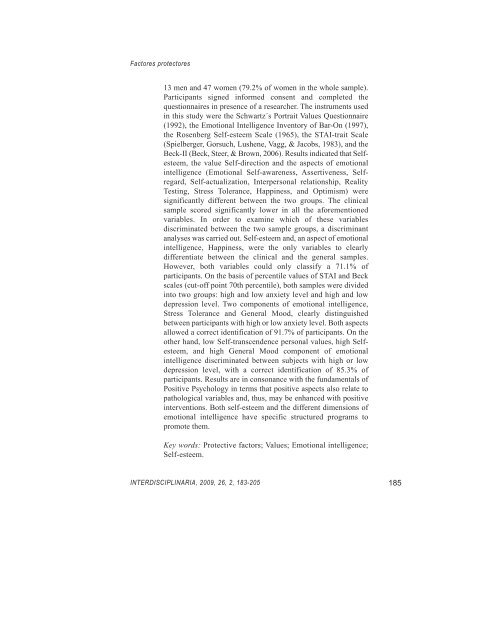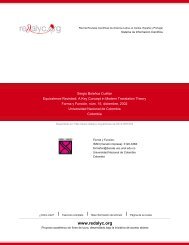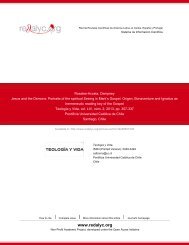Redalyc.FACTORES PROTECTORES DE LA SALUD MENTAL: UN ...
Redalyc.FACTORES PROTECTORES DE LA SALUD MENTAL: UN ...
Redalyc.FACTORES PROTECTORES DE LA SALUD MENTAL: UN ...
You also want an ePaper? Increase the reach of your titles
YUMPU automatically turns print PDFs into web optimized ePapers that Google loves.
Factores protectores<br />
13 men and 47 women (79.2% of women in the whole sample).<br />
Participants signed informed consent and completed the<br />
questionnaires in presence of a researcher. The instruments used<br />
in this study were the Schwartz´s Portrait Values Questionnaire<br />
(1992), the Emotional Intelligence Inventory of Bar-On (1997),<br />
the Rosenberg Self-esteem Scale (1965), the STAI-trait Scale<br />
(Spielberger, Gorsuch, Lushene, Vagg, & Jacobs, 1983), and the<br />
Beck-II (Beck, Steer, & Brown, 2006). Results indicated that Selfesteem,<br />
the value Self-direction and the aspects of emotional<br />
intelligence (Emotional Self-awareness, Assertiveness, Selfregard,<br />
Self-actualization, Interpersonal relationship, Reality<br />
Testing, Stress Tolerance, Happiness, and Optimism) were<br />
significantly different between the two groups. The clinical<br />
sample scored significantly lower in all the aforementioned<br />
variables. In order to examine which of these variables<br />
discriminated between the two sample groups, a discriminant<br />
analyses was carried out. Self-esteem and, an aspect of emotional<br />
intelligence, Happiness, were the only variables to clearly<br />
differentiate between the clinical and the general samples.<br />
However, both variables could only classify a 71.1% of<br />
participants. On the basis of percentile values of STAI and Beck<br />
scales (cut-off point 70th percentile), both samples were divided<br />
into two groups: high and low anxiety level and high and low<br />
depression level. Two components of emotional intelligence,<br />
Stress Tolerance and General Mood, clearly distinguished<br />
between participants with high or low anxiety level. Both aspects<br />
allowed a correct identification of 91.7% of participants. On the<br />
other hand, low Self-transcendence personal values, high Selfesteem,<br />
and high General Mood component of emotional<br />
intelligence discriminated between subjects with high or low<br />
depression level, with a correct identification of 85.3% of<br />
participants. Results are in consonance with the fundamentals of<br />
Positive Psychology in terms that positive aspects also relate to<br />
pathological variables and, thus, may be enhanced with positive<br />
interventions. Both self-esteem and the different dimensions of<br />
emotional intelligence have specific structured programs to<br />
promote them.<br />
Key words: Protective factors; Values; Emotional intelligence;<br />
Self-esteem.<br />
INTERDISCIPLINARIA, 2009, 26, 2, 183-205 185

















